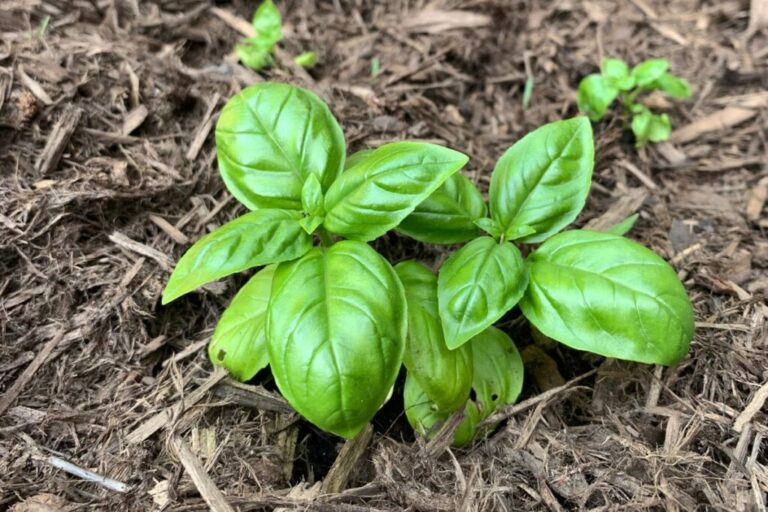#Seeking #bountiful #basil #gardeners #trick #boosting #growth #yearround
If you’re anything like me, you know how important fresh basil is in the kitchen. Nothing beats the smell of those green leaves or the taste they add to your favorite pasta sauce or salad.
But what about those of us who struggle to keep our basil plants alive and growing well throughout the year? Is there hope for our sad, leggy plants? Read on…spoiler alert: THERE IS GOOD NEWS AHEAD!
Keeping Basil Roots Warm
Warm roots are essential for the health and vigor of your basil plants. To achieve this, here are some effective strategies:
-
Heat the Soil: Place your basil on a propagation heating mat which will keep the soil at a steady warm temperature, fostering quick growth and robust roots, particularly when the weather is cool.
-
Select Black Containers: Choose black pots for your basil as they absorb heat better, helping the soil stay warm.
-
Mulch for Temperature Control: Surround your basil with a generous layer of mulch. This not only conserves soil moisture but also insulates the roots, helping to maintain a steady soil temperature.
-
Smart Pot Placement: During the chillier seasons, position your basil pots in areas that enjoy ample sunlight throughout the day, or use grow lights as an additional source of light and heat.
Consistent Feeding for Vibrant Growth
To encourage robust and verdant basil plants, it’s crucial to provide them with a consistent supply of nutrients. Begin by choosing a fertilizer rich in nitrogen, which is vital for promoting vigorous, green foliage.
- Nitrogen-Rich Fertilizer: Basil thrives on nitrogen. Seek out a specifically formulated product.
Feeding Schedule:
- Bi-Weekly Nourishment: During the peak growing period, apply a half-strength liquid fertilizer to your basil every two weeks.
- Seasonal Adjustments: In winter, if your basil plants are not under indoor grow lights, space out the feedings further.
Proper Watering Techniques
Basil requires consistent moisture but cannot tolerate waterlogged conditions. Water deeply when the top inch of soil feels dry to the touch, typically every 3-4 days depending on temperature and humidity.
Morning watering is preferable as it allows foliage to dry before evening, reducing disease risk. Always water at the base of plants rather than overhead to keep leaves dry.
During hot summer months, container-grown basil may need daily watering. Use room-temperature water to avoid shocking the roots.
Signs of Improper Watering:
- Wilting despite moist soil = overwatering
- Crisp, brown leaf edges = underwatering
- Yellowing lower leaves = inconsistent watering
Mulching around plants with a thin layer of compost helps retain soil moisture and regulate temperature. This reduces watering frequency and stress on plants, particularly during heat waves.
Essential Light Requirements
Basil plants require substantial sunlight to develop properly. They need 6-8 hours of direct sunlight daily for optimal growth and flavor development. Southern or western-facing windows are ideal for indoor growing.
During winter months, natural light often becomes insufficient. Supplement with full-spectrum grow lights positioned 6-12 inches above plants for 10-12 hours daily to prevent leggy growth.
Light intensity affects essential oil production in basil leaves. Plants receiving adequate light develop stronger aromas and more robust flavors than those grown in shadier conditions.
If basil leaves appear pale or stems become elongated, this indicates insufficient light exposure. Rotate plants regularly to ensure even light distribution and prevent them from leaning toward the light source.
Soil Composition for Thriving Basil
Basil performs best in well-draining, fertile soil with a pH between 6.0 and 7.0. A quality potting mix with added compost provides an excellent foundation for container-grown basil.
Ideal Soil Composition:
- 60% high-quality potting soil
- 20% compost or worm castings
- 10% perlite
- 10% vermiculite or coconut coir
Avoid heavy clay soils that retain too much moisture. Excess water around roots can lead to fungal diseases and root rot.
Incorporate organic matter like compost to improve nutrient availability. Light applications of balanced organic fertilizer (such as 5-5-5) every 4-6 weeks during the growing season support continuous leaf production without causing excessive, flavor-diminishing growth.
The Gardener’s Trick: Proven Techniques for Abundant Basil
Basil thrives with specific care techniques that maximize its aromatic leaves and sturdy growth. Professional gardeners rely on three key approaches that transform ordinary basil plants into productive herbs that can flourish throughout the growing season.
Strategic Pruning for Increased Yield
Regular pruning is the cornerstone of abundant basil production. When basil plants reach 6-8 inches in height, pinch off the top set of leaves to encourage bushier growth. This technique prevents the plant from flowering too early and extends the harvesting period.
Always cut just above a leaf node using clean, sharp scissors to minimize stress on the plant. For optimal results, harvest from the top down, removing no more than one-third of the plant at a time.
Morning pruning allows plants to recover throughout the day and reduces moisture-related diseases. Establish a consistent pruning schedule every 2-3 weeks during peak growing season to maintain plant vigor.
Many gardeners overlook the importance of removing flower buds immediately. Once basil flowers, the leaves become bitter and production slows significantly.
Companion Planting for Healthier Growth
Basil performs exceptionally well when planted alongside compatible vegetables and herbs. Tomatoes and basil create a mutually beneficial relationship – basil repels tomato hornworms while tomatoes enhance basil flavor.
Plant basil near peppers to deter aphids and other common garden pests. Marigolds also make excellent companions as their strong scent masks the aroma that attracts destructive insects.
Avoid planting basil near rue or sage, as these herbs can inhibit basil’s growth through chemical competition. Space basil plants 12-18 inches apart to ensure adequate airflow and prevent fungal issues.
For container gardens, pair basil with shallow-rooted herbs like thyme or oregano. These combinations maximize space while creating beneficial microclimates.


